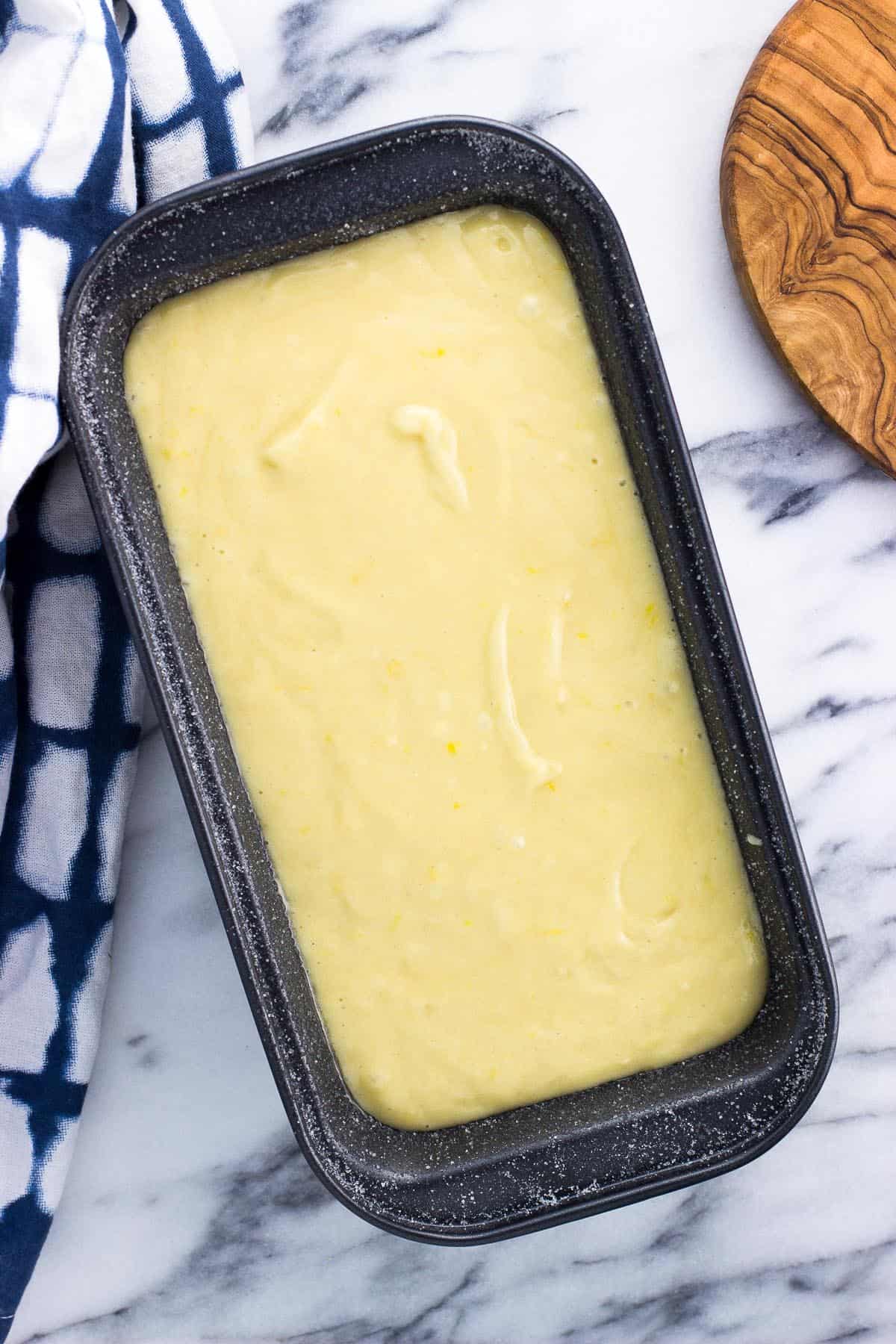This lemon yogurt cake recipe produces a soft and tender loaf cake bursting with lemon and made with a blend of oils for a nice flavor addition. It's perfect for brunch and dessert alike!

Since I've been stretching out the time between my grocery trips as long as I can, I've started adding several ingredients to my orders without having any specific plans for them. Recently one of these extras has been a big tub of plain Greek yogurt.
Besides eating by itself or in smoothies, it's an integral part of this tremendous Greek yogurt caesar salad dressing and adds a healthy touch to creamy celery soup. Truly a kitchen workhorse.
This go around I went the sweet route and worked on a yogurt dessert recipe. And in honor of spring approaching, I packed it full of bright and cheery lemon flavor to act as a nice pick-me-up as the weather (fingers crossed!) begins to warm up.
Reasons to Love This Recipe
- Yogurt adds a ton of tenderness and moisture to baked goods, and its tanginess pairs so well with citrus flavors. And the blend of oils? One in particular adds a complementary hint of flavor we can't get enough of.
- It has easy prep, which can be boiled down to combining the wet and dry ingredients first separately and then together, then baking until done.
- Lemon yogurt cake is versatile! This cake is sweet but not overly so, served with a simple dusting of confectioners' sugar in place of a perhaps more traditional icing glaze. It would totally work as a brunch dessert or sweet morning snack.
Recipe Ingredients

- Yogurt: Plain Greek yogurt is optimal to make this lemon yogurt cake as it's thicker than regular yogurt (but regular, non-Greek yogurt is fine, too). And because of the additional oil added to the recipe, the fat percentage isn't crucial. I tested this recipe the most with nonfat yogurt, but you could also use low-fat or whole milk varieties if you prefer.
- Oil: Oil is the other part of the equation that provides moisture and a tender crumb in this cake. Using a 50:50 blend of a neutral oil (like canola or vegetable) and extra-virgin olive oil won out in my testing. Olive oil lends a hint of its unique flavor and a slight Mediterranean feel that truly meshes well with the citrus flavors here.
- Lemon: Two tablespoons of freshly-squeezed lemon juice and one tablespoon of lemon zest bring a bright and bold lemon flavor to this yogurt cake. One medium to large lemon should be all you need (with a little lemon juice left over).
Greasing and Sugaring the Pan
The first step to this recipe is to prepare the pan, which in this case means greasing and sugaring. Most commonly done with flour, coating the pan with something extra helps the batter grip the sides of the pan as it bakes. This results in taller baked goods that have a nicely risen center.
While this recipe certainly works fine with flouring, I loved the extra special touch sugaring the pan provided. The granulated sugar melts into the crust to make it extra hearty and brings a tiny bit of extra sweetness. And that's a welcome turn of events seeing as this lemon yogurt cake isn't iced or glazed.
Step-by-Step Instructions
- Begin by greasing your loaf pan with either cooking spray or unsalted butter, then sprinkle one to two teaspoons of granulated sugar in the pan. Shake and tilt the pan around to have the sugar adhere to the bottom and all sides, and then tap out the excess over the garbage to discard.

- Whisk together flour, baking powder, and salt in a mixing bowl. If you have mixing bowls of different sizes, use a smaller one for the dry ingredients.
- Now get a separate mixing bowl and add the sugar, yogurt, eggs, canola/vegetable oil, olive oil, lemon juice and zest, and vanilla extract. Whisk until smooth and very well-combined. You can do this by hand; I usually don't pull out an electric mixer for this one.


- Pour the dry ingredients over top of the wet ingredients.
- Whisk until everything is combined and no dry streaks of flour remain. The batter should be nearly all smooth (the tiny lump-like things in the batter photo below are air bubbles).


- Pour the batter into the prepared (greased and sugared) pan. Bake for 45-50 minutes, or until the edges of the lemon yogurt cake are golden-brown and a tester, such as a toothpick or a long piece of dry spaghetti inserted into the center of the loaf comes out clean.

- Let this cake cool in the pan for twenty minutes, then loosen the edges with a thin spatula or a knife and transfer it to a wire rack to fully cool before slicing, dusting with confectioners' sugar, and serving.
Recipe Tips
- It's easier to zest the lemon first while the lemon is whole before slicing it in half to juice!
- Resist the urge to open the oven door to check on this lemon yogurt cake as it's baking, as the influx of cooler air can interfere with the cake rising. Rely on your oven light to keep tabs on its progress, or shine a flashlight in your oven door window if you need to replace the lightbulb (like me!). If you do have to open the door to peek, wait until near the end of the timer time to take a quick look.
- Chocolate lovers rejoice - there's now a chocolate yogurt cake, too. The sugared pan produces edges that taste like the best, most chewy brownie ends.
Recipe FAQs
Once completely cooled, wrap the cake with plastic wrap and store at room temperature for several days. If you've eaten several slices already, opt to press the plastic wrap against the cut-side of the loaf to keep it fresher (versus draping plastic wrap over top of a loaf pan, which would trap air in there).
Yes, this cake freezes well. Just like when storing at room temperature, wrap it fairly snugly in plastic wrap, then wrap it in a layer of aluminum foil or place it in an air-tight bag (pressing the excess air out).
This cake can be taken in many different directions to serve. Simple whipped cream (or stabilized whipped cream!) and fresh fruit are a classic pairing. Stewed rhubarb sauce will bring a seasonal spring touch. You can also drizzle a glaze over top instead of dusting with powdered sugar.

More Lemon Baked Goods
If you’ve enjoyed this recipe, I’d love for you to leave a star rating in the recipe card and/or a comment review below!

Lemon Yogurt Cake
Ingredients
- 1 ½ cups (186g) all-purpose flour
- 2 teaspoons baking powder
- ½ teaspoon salt
- 1 cup granulated sugar plus 2 teaspoons for preparing the pan
- ⅔ cup plain yogurt (I usually use Greek)
- 3 large eggs
- ¼ cup neutral-tasting oil such as canola or vegetable
- ¼ cup extra-virgin olive oil
- 2 Tablespoons lemon juice
- 1 Tablespoon grated lemon zest (from about 1 large lemon)
- 1 teaspoon vanilla extract
- Confectioners' sugar for dusting
Instructions
- Preheat oven to 350°F. Grease an 8 ½" x 4 ½" loaf pan with unsalted butter or cooking spray, then sprinkle 1-2 teaspoons of granulated sugar all over the greased pan to coat the bottom and sides well. Shake out any excess sugar. Set aside pan for now.
- In a medium mixing bowl add flour, baking powder, and salt and whisk to combine.
- In a separate mixing bowl add 1 cup granulated sugar, yogurt, eggs, both oils, lemon juice, lemon zest, and vanilla extract. Whisk to combine very well (by hand is fine, but you can use an electric mixer if you prefer).
- Add the dry ingredients to the bowl with the wet and whisk until combined evenly, smooth, and no flour streaks remain. Take care not to overmix the batter at this point as that can lead to a tougher crumb. Pour out batter into the prepared loaf pan.
- Bake for 45-50 minutes, or until the edges are golden-brown and a tester inserted into the center of the loaf comes out clean. Let the cake cool in the pan for 20 minutes, then carefully run a thin spatula or paring knife along the sides of the pan to loosen it before transferring it to a wire rack to cool completely before slicing. Dust with confectioners' sugar just prior to serving.
Notes
- This recipe was made and tested in an 8 ½" x 4 ½" loaf pan. A 9" x 5" pan will also work, though your cake will be less tall and the bake time will likely need to be adjusted down.
- It's easier to grip a whole lemon to zest it than to try and zest it after it's been sliced and juiced.
- Try not to open the oven door as this cake is baking, as cool air entering the oven can interfere with the cake rising. If you cannot rely on your oven light or peeking through the oven door window, wait until towards the end of the bake time to quickly take a look.
Nutrition
Nutritional information is provided as an estimate. As it can vary due to many factors (brands used, quantities, etc.), we cannot guarantee its accuracy.
Food Safety and Nutrition DisclaimerRecipe adapted from Food Network
Would you like to save this?
Plus receive periodic recipe newsletter emails.






Susan O says
I made this cake for the first time and it came out fantastic. I used all canola oil as the notes stated was good too. The cake was so moist on the inside with a bit of a crispy outside. I drizzled some glaze on it too. I am keeping this recipe as my go to lemon cake.
Alyssa says
I'm so happy to hear that, Susan! Thank you leaving a review.
Allynne says
Easy and delicious. The olive oil is an excellent addition! The texture is perfect!!
Alyssa says
I'm so happy you like it!